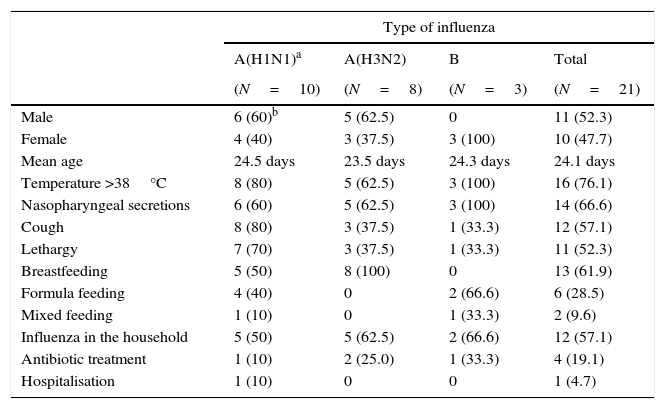Influenza is a viral infection affecting the general population, but especially the very old and the very young. Paediatric influenza is found primarily in children under 5 years old. The symptoms are fairly non-specific below 2 years of age and it is only from the age of 4–5 years that its clinical manifestations can guide us towards this disease.1
There are few existing studies on neonatal influenza (at less than 28 days of age) that focus on the influenza A (H1N1) pandemic.2–4 For this reason we present a prospective study on the cases detected in the last 3 influenza seasons (2012/13, 2013/14 and 2014/15).
A nasopharyngeal aspirate was taken from patients who attended the emergency department during the flu months. Influenza viruses were detected using a real-time RT-PCR (reverse transcription polymerase chain reaction) technique (Anyplex® RV16; Seegene, South Korea). The medical records of neonates diagnosed with influenza were reviewed.
Over the course of the 3 seasons 1215 cases of flu were diagnosed, 631 (51.9%) of which were in children under 15 years of age. Of these, 21 cases presented in neonates (3.3% of the total number of influenza cases studied). The mean age was 24.1 days (range, 5–28 days). The youngest patients (5 and 9 days old) had an influenza A strain (H3N2). Table 1 presents the general characteristics of the neonates studied. Three patients had a history of prematurity and one had previously had bronchiolitis due to RSV (respiratory syncytial virus). None of the patients died as a consequence or by reason of influenza. None of the mothers had been vaccinated against influenza during pregnancy.
General characteristics of the patients diagnosed with neonatal influenza.
| Type of influenza | ||||
|---|---|---|---|---|
| A(H1N1)a | A(H3N2) | B | Total | |
| (N=10) | (N=8) | (N=3) | (N=21) | |
| Male | 6 (60)b | 5 (62.5) | 0 | 11 (52.3) |
| Female | 4 (40) | 3 (37.5) | 3 (100) | 10 (47.7) |
| Mean age | 24.5 days | 23.5 days | 24.3 days | 24.1 days |
| Temperature >38°C | 8 (80) | 5 (62.5) | 3 (100) | 16 (76.1) |
| Nasopharyngeal secretions | 6 (60) | 5 (62.5) | 3 (100) | 14 (66.6) |
| Cough | 8 (80) | 3 (37.5) | 1 (33.3) | 12 (57.1) |
| Lethargy | 7 (70) | 3 (37.5) | 1 (33.3) | 11 (52.3) |
| Breastfeeding | 5 (50) | 8 (100) | 0 | 13 (61.9) |
| Formula feeding | 4 (40) | 0 | 2 (66.6) | 6 (28.5) |
| Mixed feeding | 1 (10) | 0 | 1 (33.3) | 2 (9.6) |
| Influenza in the household | 5 (50) | 5 (62.5) | 2 (66.6) | 12 (57.1) |
| Antibiotic treatment | 1 (10) | 2 (25.0) | 1 (33.3) | 4 (19.1) |
| Hospitalisation | 1 (10) | 0 | 0 | 1 (4.7) |
No gender differences between the various influenza viruses were observed in the neonates studied, except in the cases of influenza B, although the number is too small to allow conclusions to be drawn; nor were differences detected in the mean age at presentation. However, Martic et al.4 reported that the mean age of neonates infected with the A (H1N1)p virus was 19.2 days and in 70% of cases they were female. The mean age of our patients in this same viral group was 24.5 days and 40% were female, which indicates possible variations depending on the population or geographical area studied.4
In most of the patients the symptoms presented were mild and hospitalisation was not required except in one case, which was due to the prematurity of the infant. Of the neonates infected with influenza A (H1N1)p virus described by Martic et al.4 100% required hospitalisation; our patient was also infected by this same virus type. This contrasts with the point reported by Martic et al.4 that 50% of the neonates were treated with oseltamivir on account of their prevailing neurological symptoms. In 4 patients (19.1%) antibiotic treatment with amoxicillin/clavulanic acid was initiated because they presented with an acute middle ear infection. In an earlier study it was reported that 40% of neonates with influenza received antibiotic therapy due to bacterial complications (pneumonia, middle ear infection and urinary infection).4
We observed that despite the fact that 61.9% of the neonates had been breastfed, they were infected with influenza. Thus it could be said that breastfeeding was not a protective factor in this study group. It should be emphasised that vaccination of the mother during pregnancy is a protective factor against neonatal influenza.
We agree with other studies3,4 that the main risk factor for neonatal influenza is the presence of influenza in the household (57.1%), and that this is especially important for cases of influenza A (H3N2) and influenza B. This family factor was detected in 90% of the neonates with influenza A (H1N1)p in our study.4
Neonatal influenza seems to be a mild or moderate condition that does not require hospitalisation due to its limited general impact. Most cases are contracted within the household and do not involve respiratory complications.
Please cite this article as: Reina J, Ferrés F. Características clínicas y epidemiológicas de la gripe neonatal. An Pediatr (Barc). 2015;83:437–438.




